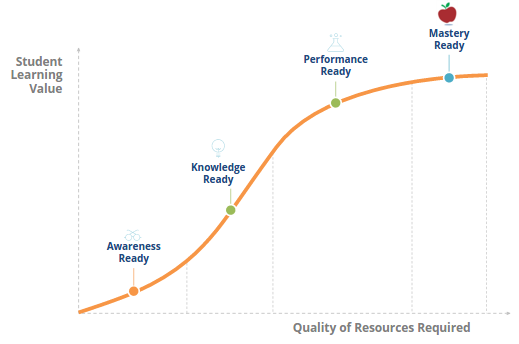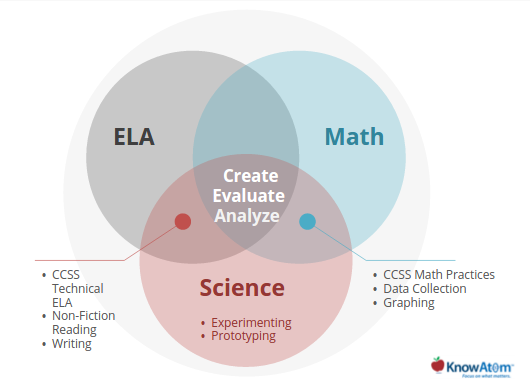The challenge right now with analyzing curriculum and tasks is that most resources you'll find are a rearticulation of other materials, and aren’t truly aligned to the Next Generation Science Standards.
We've been around for the last ten years developing curriculum and watching this process, and we’ve been going all in on the Next Generation Science Standards by taking the suggestions of various reports as they were coming out in 2010 and 2011, and putting them into practice in the classroom right away. We hope to see more teachers do the same because these standards are great for students and they're great for instruction.
The problem is that most of the resources that are out there are taking a very isolated approach.
We think a more comprehensive approach is appropriate, especially when it comes to student readiness levels. Whether or not students are successful in the STEM realm should not be measured by the students’ ability to perform a specific task, but by their ability to use the science and engineering practices to answer a question or solve a problem.

Student readiness exists on a curve, starting with awareness of a topic, building through knowledge and performance readiness, and culminating in mastery readiness. With each step up, the teacher requires better resources in order to instill readiness in students.
1st Level: Awareness Ready
Let’s start with awareness readiness, which is the most basic level. The goal of an awareness-ready resource is straightforward: to make students aware of the basic aspects of STEM. Museums are common awareness-ready resources because they make students aware about historical scientific discoveries and the people who made them. Other awareness-ready resources are the kinds of resources you get from field trip providers or companies who engage in science- and technology-related activities.
Oftentimes the goal of these awareness-ready resources is to make students aware about the answers to basic aspects of questions such as:
- What does it mean to be a scientist?
- What does it mean to be an engineer?
- How does XYZ company actually use a specific concept from science?
- How did scientists and/or engineers at XYZ company use their knowledge of science to answer questions or solve problems?
2nd Level: Knowledge Ready
The second level is knowledge readiness, which provides students with knowledge about STEM.
To promote knowledge of a concept, subject or core principle, teachers need resources.
A lot of times these resources come from textbooks, workbooks or handouts. Nonfiction written materials are an effective way to introduce students to a subject and build awareness and knowledge readiness.
3rd Level: Performance Ready
Performance-ready resources equip students to tackle a specific task in a specific context. Most science kits are performance-ready resources because they teach students about one particular area of knowledge, and ask them to perform a task that demonstrates that knowledge.
Students aren’t ready to become scientists or engineers themselves simply because they can perform a specific task, however, because they haven’t yet developed a specific set of skills or proficiency with practices. However, the light is on. They understand what scientists and engineers do, and can connect scientific principles with the mechanics of what engineers do.
Building their awareness and their knowledge base through background knowledge helps ready them for putting this knowledge to use through practices, but it isn’t enough.
By this we mean that awareness of a concept or core principle and knowledge of background information are necessary building blocks in the process, but they are not the same as activating and connecting that knowledge through actual, physical, student-driven practices.
Further building student awareness of concepts, and strengthening their knowledge base through the judicious application of vocabulary and relevant concepts help to construct the background knowledge necessary to ready students to engage with materials in a hands-on, student-led fashion. It’s a crucial beginning. Now it’s time to connect this awareness with real practices.
4th Level: Mastery Ready
The highest level of readiness is mastery readiness, which is aimed at developing transferable skills. The knowledge that students absorb in the establishing background knowledge phase must be linked to actual practices – to skills students can build and tasks they can accomplish with that knowledge – before it is to be of any use generating new scientists and engineers who will someday work in STEM careers.
To connect knowledge with practices intelligently, we must take into account all disciplines. That isn’t as hard as it sounds:
As we think about the next generation model of instruction, we are engaging across disciplines.
We are not isolating concepts or even isolating science by itself. Students who are engaged in the pursuit of STEM concepts are not using isolated skills, after all; they're engaging with ELA and math standards as well, specifically Common Core math practices and Common Core technical ELA standards.
In a middle school lab, for instance, we might see students experimenting and prototyping. So how do students approach a question? They use a scientific process. How do they approach a problem? They use an engineering design process. As they’re carrying out that process, they’re creating an ELA nonfiction text, which is a plan to carry out tests, gather data, and form a conclusion.

STEM practices rely heavily on science and engineering principles, but don’t get far without tying in math and ELA core concepts.
This is the tipping point between awareness, knowledge, and performance (generated through exposure to resources, the building of background knowledge and task-oriented resources) and the ability to do something with that knowledge base … this is where we activate that existing knowledge and begin to connect it with a set of useful scientific practices that draw on myriad subjects.
Once students can identify which skills are useful for solving a problem or answering a question, they can begin to build up a set of practices for approaching all questions and problems.
Mastery readiness takes the form of students being able to employ a skill within a specific but unfamiliar context and use that skill to arrive at a conclusion.
At this point, they are able to create, evaluate and analyze the context in light of what's been given to them.
Mastery readiness is also about taking those skills beyond performance of a specific task. Students should be able to use those skills in a variety of ways, to go into any context and employ those skills, to consider the results, and to come to their own conclusions. That's why promoting mastery of skills over task performance is so important.




